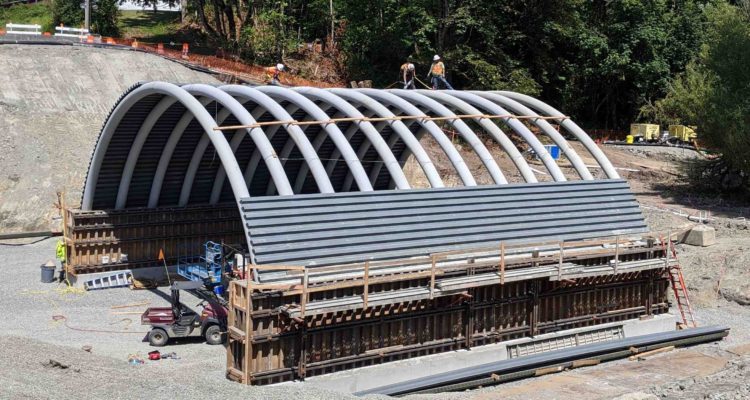The analyses showed the composite bridge could handle all the hazards. “We found that this bridge is actually more seismic-resistant than the traditional structures that are out there today,” Sweeney says. Unlike a rigid concrete structure, which can’t move easily with seismic waves, flexible composite arches can sway and then return to their original positions. The concrete reinforcement is contained within the tubes, so it moves with them. To further strengthen the bridge, AIT used carbon fiber reinforcement for the anchors that connect the arches with the concrete footers.
The company built the GArches using a braided fabric to get the required arch shape. “It also gives us the ability to put the strength of the fabric in the direction that we need it,” Sweeney explains. Workers placed the fabric over an inflated, balloon-like frame and used a vacuum infusion process with a vinyl ester resin to cure the arches. They were removed from the mold the next day.
Each of the 12 arches for the SR 203 project weigh 300 pounds and provide 54 feet of space between the two ends. To get them to the job site, AIT cut them in half and made a sleeve to splice them back together on site. The two flatbed trucks that transported them cross-country didn’t require special permits for weight or size on the three-day trip.
The 41 pultruded GDeck panels, which span a total of 49 feet, were manufactured by Creative Pultrusions using AIT’s design and delivered on a separate truck.
The general contractor removed 26,000 cubic yards of earth from the site to create room for the composite bridge installation. Once the site was ready, it took only a week-and-a-half to install the arches, screw in the decking panels and fill the arches with concrete. “Even though we knew this would be erected really quickly out in the field, the speed surprised us,” says Gaines. “It didn’t take very long for them to get their tubes in place, to get all the decking in place and start the backfill process.”
After the composite arch and deck panels were erected, the contractor replaced the earth over the arch and around the sides of the structure, then built an asphalt pavement on that foundation to carry traffic over the stream. The road was closed for just over 30 days. The $8.2 million bridge reopened to traffic in August 2020.
“When you walk into a brand-new product like this, there’s a certain level of risk. But there were just no issues at all with the construction,” Gaines says. As a result, WSDOT has updated its bridge specifications to allow construction of more composite bridges. No additional projects are scheduled now, but the department is likely to build more since the cost of the composite bridge is competitive with the pre-cast structures.
Sweeney expects the success of this project, and the many benefits that composite bridges offer, will encourage their further adoption on the West Coast. “Making the sustainability case is going to be big, because one of the markets we’re trying to open up right now is California,” he adds.
Mary Lou Jay is a freelance writer based in Timonium, Md. Email comments to mljay@comcast.net.


